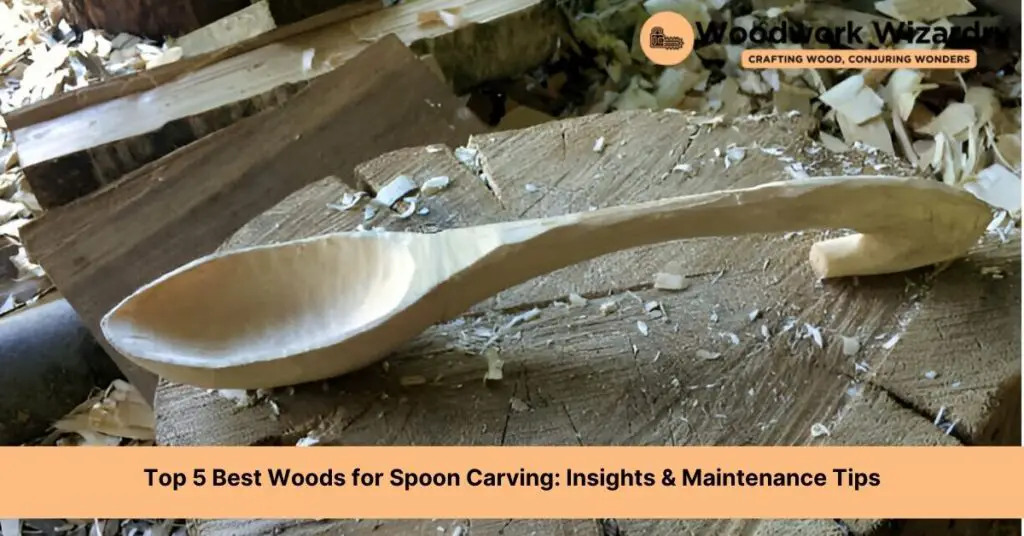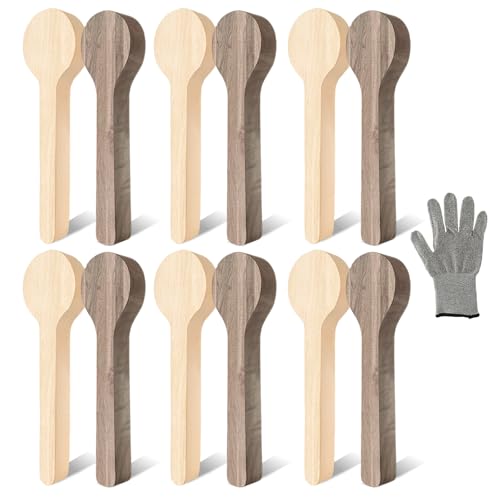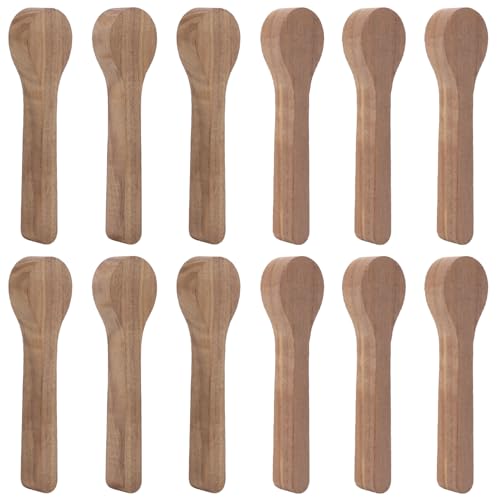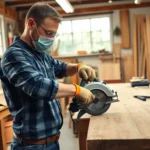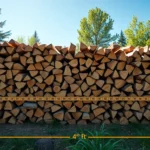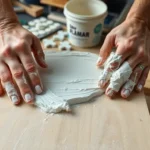In the world of spoon carving, not all woods are created equal. We’ve all been there, standing in front of a selection of wood, wondering which one will transform into that perfect spoon. It’s a craft that marries the beauty of nature with the satisfaction of creating something both beautiful and functional. But with so many options, how do we choose the right wood for our next project?
Let’s dive into the heart of spoon carving, where the choice of wood can make all the difference. We’ll explore the best woods that not only make your carving process a joy but also ensure your spoon lasts through countless meals and memories. Whether you’re a seasoned carver or just starting, understanding the characteristics of these woods will elevate your craft to new heights. So grab your carving tools, and let’s get started on this exciting journey together.
Essentials of Choosing Wood for Spoon Carving
Following from our discussion on the importance of selecting the right wood, let’s dive deeper into the specifics. Understanding these essentials ensures your spoon carving journey is both enjoyable and rewarding.
Grain Orientation and Texture
The grain of the wood plays a vital role in the spoon’s final look and feel. We prefer woods with a straight, consistent grain, as they’re easier to carve and yield a smoother finish. For a unique look, we also explore woods with interesting grain patterns, like birdseye maple or spalted wood. However, it’s important to remember that intricate patterns might require more skill to carve. The ideal texture is medium-fine; it’s soft enough to carve smoothly but hard enough to hold detail and maintain durability.
Hardness and Durability
While picking out wood, we always weigh its hardness and durability. Softwoods like pine or cedar are easy to carve but might not withstand the test of time if the spoon is used daily. On the other hand, hardwoods like cherry, walnut, and maple offer the perfect balance between carve-ability and longevity. They’re tough enough to handle daily use but still gentle on the knife. We aim for woods with a Janka hardness rating that’s not too soft, ensuring the spoon doesn’t get nicked or dented easily, nor too hard, making carving a chore.
Availability and Sustainability
Lastly, we consider the wood’s availability and its impact on the environment. We lean towards locally sourced woods, as they’re not only readily available but also reduce the carbon footprint associated with transportation. Woods like birch, beech, and cherry are commonly found in many regions and offer excellent material for spoon carving. We’re also mindful of sustainability; opting for wood from responsibly managed forests is part of our commitment to the craft and the planet. Forestry certifications like FSC (Forest Stewardship Council) are a great indicator of sustainable choices, ensuring the wood we use doesn’t contribute to deforestation or habitat destruction.
Top 5 Best Woods for Spoon Carving
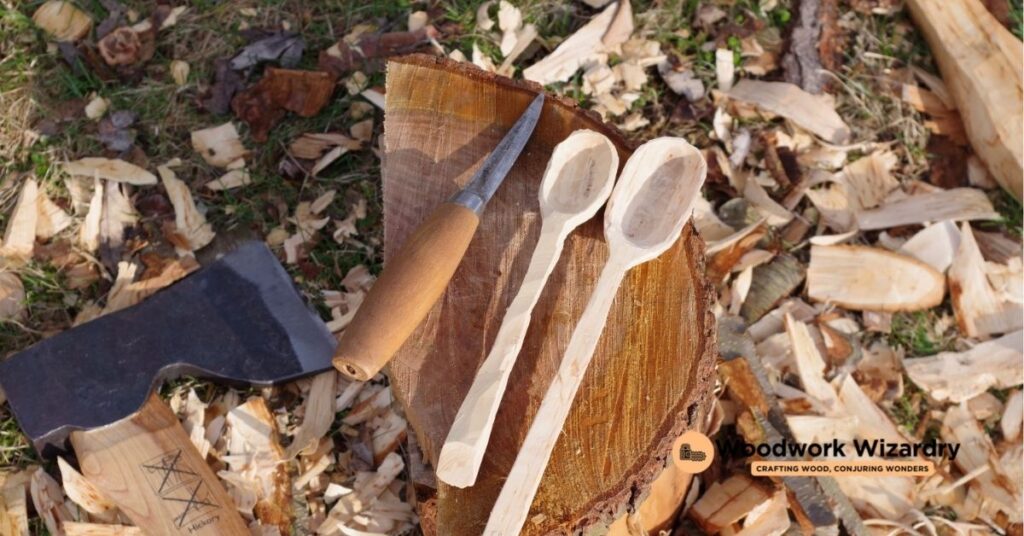
Building on our discussion about the essentials of choosing the right wood for spoon carving, let’s dive into our top picks. Each of these woods offers unique benefits for carvers, balancing grain orientation, texture, hardness, and durability.
Birch: The Carver’s Favorite
Birch tops our list for several reasons. It’s a joy to work with, thanks to its fine grain and softness compared to other hardwoods, making it ideal for beginners. Birch’s pale color offers a beautiful canvas, highlighting the subtle details in your carving. Moreover, it’s readily available in cooler climates, making it a sustainable choice for many carvers.
Cherry: Durable and Beautiful
Cherry wood stands out for its rich color that deepens over time, adding a layer of beauty and elegance to carved spoons. Apart from its visual appeal, cherry is also remarkably durable and resistant to wear and tear. Its fine, straight grain allows for smooth carving and a professional finish, making it a favorite among experienced carvers.
Maple: Hard and Versatile
Maple’s hardness is unmatched, making it an excellent choice for carving spoons that are meant to last. It’s a versatile wood, suitable for both intricate details and the smooth, sweeping curves of spoons. Maple’s light color and subtle grain pattern offer a modern look, appealing to carvers aiming for a minimalist aesthetic.
Walnut: Rich Color and Grain
Walnut wood is prized for its deep, rich color and striking grain patterns, bringing a luxurious look to any spoon carving project. While slightly harder to carve due to its density, walnut’s durability makes it well worth the effort. Its natural oils provide a built-in resistance to moisture, extending the lifespan of your spoons.
Beech: Tough and Reliable
Beech is the unsung hero of spoon carving woods. It’s hard and dense, providing excellent durability for everyday use. Beech’s uniform, fine grain ensures a smooth carving experience and a polished end product. Plus, its light color can be easily stained or left natural for a classic look, making beech a versatile option for carvers seeking reliability and quality.
Characteristics of Each Recommended Wood
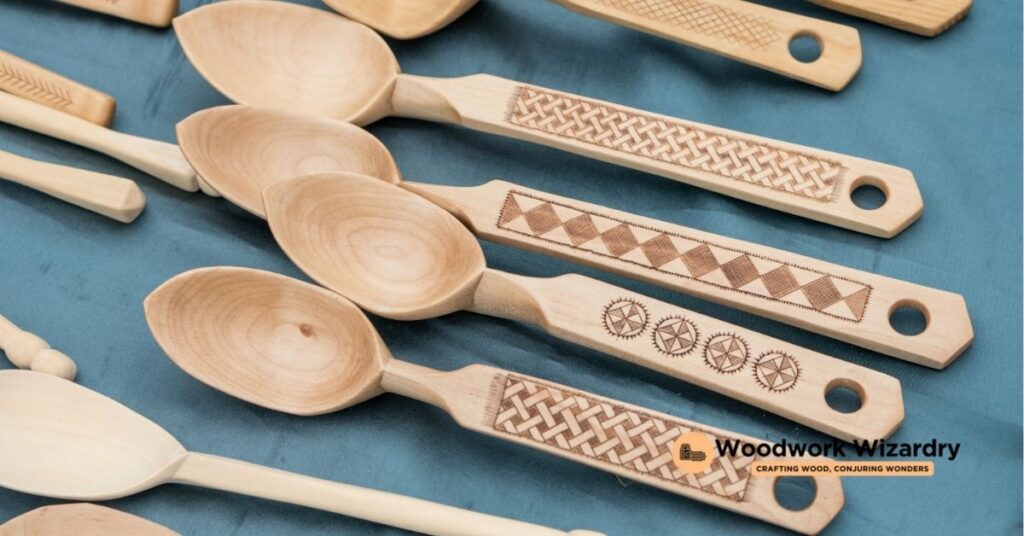
Let’s dive deeper into what makes each of these woods exceptional for spoon carving, taking a closer look at their distinct traits.
Birch: Ideal for Beginners
Birch is our go-to recommendation for anyone just starting out in spoon carving. Its softness allows for easy cutting, making it a fantastic choice for practicing basic techniques. Plus, birch has a fine grain that’s not only beautiful but also forgiving, so beginners can achieve satisfying results without too much frustration. Moreover, its availability and affordability make it an accessible option for those just dipping their toes into the craft.
Cherry: Aging Gracefully
Cherry wood truly shines with time, developing a rich, deeper color as it ages. We love cherry for its smooth grain and durability, which make it a joy to work with and ensure the finished spoon can withstand years of use. Its natural resistance to decay and the way it gracefully ages, deepening in color, gives each carved piece a unique, evolving beauty. Cherry’s workability allows for both simple and moderately intricate designs, making it versatile for carvers of varying skill levels.
Maple: For Intricate Designs
Maple stands out for its tight, even grain, making it excellent for those detailed spoon designs we all admire. It’s harder than birch and cherry, offering a sturdy base for intricate work without sacrificing smoothness in carving. We particularly recommend maple for experienced carvers looking to challenge themselves with more elaborate projects. Plus, its light color offers a beautiful backdrop that highlights the craftsmanship of each piece.
Walnut: The Premium Choice
Walnut’s rich color and distinctive grain patterns make it a premium option for spoon carving. Its hardness is balanced with a rewarding carving experience, producing stunning pieces that anyone would be proud to display or use. Walnut isn’t just about looks; it’s also durable, ensuring that spoons carved from it are as functional as they are beautiful. For those looking to make an investment in their crafting, walnut is a top choice.
Beech: Best for Hefty Spoons
Beech is our pick for those who like their spoons a bit on the heavier side. It’s tough and durable, with a fine grain that stands up well to regular use. This wood is particularly suited for carving spoons intended for cooking or serving, where a bit more heft is beneficial. Beech’s reliability and toughness make it a favorite for utensils that need to withstand the test of time and usage. Plus, its light color and subtle grain patterns provide a classic look that blends seamlessly with any kitchen aesthetic.
Tips for Working With Different Woods
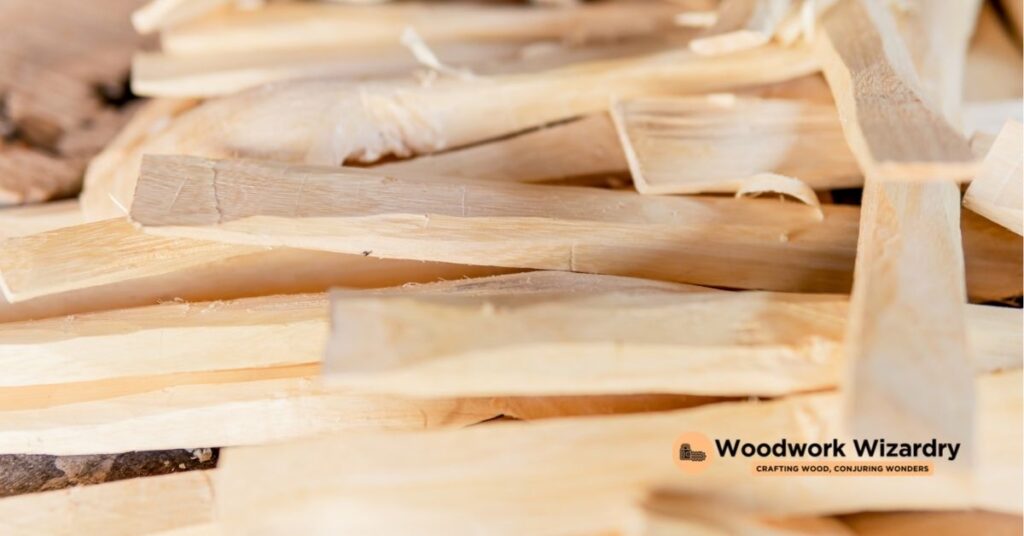
When diving into the world of spoon carving, knowing how to work with different woods can really elevate your craft. Let’s share some tips to help you get the best out of each wood type.
Preparing Your Wood
- Check for Moisture Content: Wood with lower moisture content carves easier, so aim for wood that’s been dried properly. Birch and Beech, in particular, work best when not too green.
- Select the Right Cut: Pay attention to grain orientation. Straight grains are ideal for durability, especially in denser woods like Maple and Walnut.
- Prepare the Surface: Use a planer or a sharp knife to smooth out the wood surface before you start. This is crucial for woods like Cherry, which can display beautiful grain patterns under a smooth surface.
Carving Techniques for Different Woods
- Softer Woods Like Birch: Use gentler strokes to avoid tearing. Birch is forgiving, making it perfect for beginners to practice detailed carving without much resistance.
- Harder Woods Like Maple and Walnut: Employ stronger, controlled cuts. Tools should be kept razor-sharp to handle the density without causing strain on your hands or damaging the wood.
- For Woods Like Cherry and Beech: Focus on directional carving, working with the grain to enhance the wood’s natural beauty and strength. Beech’s toughness calls for patience and can withstand deeper cuts.
- Sanding Smooth: Start with a coarse grain and work up to a fine grain for a silky finish. This is essential for all wood types but pay extra attention to denser woods to reveal their rich colors and patterns.
- Oiling for Protection: Use food-safe oils, like linseed or mineral oil, to protect your spoon. Each wood absorbs oil differently, with Birch and Beech soaking it up more readily, enhancing their grain.
- Regular Maintenance: Encourage owners to re-oil their spoons periodically. This is especially important for spoons made from Cherry and Walnut to maintain their durability and color over time.
By following these tips tailored for each wood type, we can ensure our carved spoons not only look beautiful but also stand the test of time. Whether you’re carving with Birch for the first time or mastering intricate designs on Maple, a little knowledge goes a long way in making your spoon carving project a success.
Tools for Effective Spoon Carving
Moving on from the best woods, let’s delve into the tools that’ll make your spoon carving journey a success. It’s all about having the right set to transform those woods into beautiful spoons.
Essential Carving Tools
To get started, you’ll need a few key tools. We’ve found these to be indispensable in our spoon-carving adventures:
- Carving Knife: Your go-to tool for shaping and detailing. Look for one with a comfortable grip and a durable blade.
- Hook Knife: Essential for hollowing out the spoon’s bowl. A good hook knife should fit snugly in your hand, allowing for controlled and precise cuts.
- Sloyd Knife: Perfect for rough cutting and whittling down your wood. Its versatility makes it a must-have in your toolkit.
- Gouges and Chisels: These come in handy for adding texture and intricate designs to your spoons. Various sizes and shapes will enable you to be as creative as you wish.
- Wood Mallet: Ideal for tasks that require a bit more force. It’s great for chiseling away larger chunks of wood without tiring out your hand.
Sharpening Your Tools
A sharp tool is a carver’s best friend. Here’s how we keep ours in top shape:
- Whetstones: Used for primary sharpening, they’re available in various grits. Start with a coarse stone and work your way up to a finer grit for a razor-sharp edge.
- Stropping: This polishing technique removes burrs and polishes the blade. Use a leather strop with a bit of polishing compound to give your tools a mirror-like finish.
- Honing Rods: Ideal for quick touch-ups. They’re great for maintaining an edge in between full sharpenings.
Caring for Your Carved Spoons
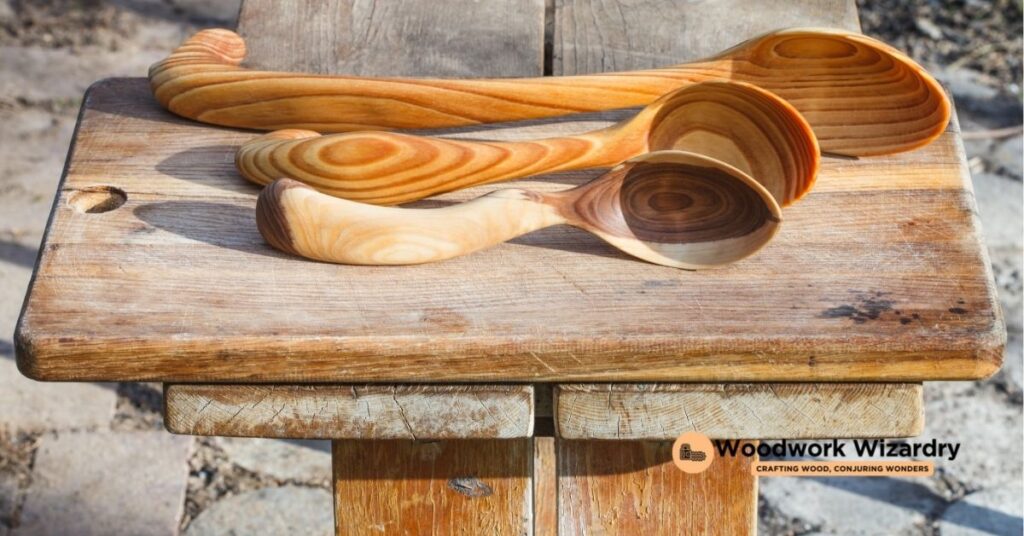
After you’ve selected the perfect wood for your spoon carving, and your creations have come to life, it’s essential to know how to care for them properly. Here, we’ll dive into cleaning, maintenance, and knowing when it’s time to refinish or repair your carved spoons.
Cleaning and Maintenance
The right cleaning method can significantly extend the life of your wooden spoons. For daily cleaning, simply rinse the spoon under warm water and use a soft sponge with mild soap to remove any residue gently. Avoid soaking wooden spoons in water, as prolonged exposure can cause the wood to swell, leading to cracks. After washing, dry your spoons immediately with a towel and allow them to air dry completely before storing.
Every few uses, it’s a great idea to disinfect your spoons. You can do this by wiping them down with a solution made from equal parts water and white vinegar. This natural disinfectant is effective yet gentle on the wood.
Oiling your spoons is an essential aspect of maintenance. We recommend doing this at least once a month or when the wood starts to look dull. Food-safe oils such as mineral oil, walnut oil, or beeswax provide a protective coating that prevents moisture absorption and keeps the wood strong. Apply a thin layer, let it sit for about an hour, then wipe off any excess.
When to Refinish or Repair
Even with diligent care, your wooden spoons will eventually show signs of wear. When you notice rough patches, scratches, or the wood becomes overly dry, it’s time to refinish them. Start by gently sanding the surface with fine-grit sandpaper to smooth out any imperfections. Once smooth, wash the spoon as outlined previously, let it dry, and then apply a generous coat of food-safe oil or a blend of oil and beeswax to restore its finish and sheen.
If your spoon suffers a more severe fate, like a crack or split, assess the damage carefully. Small cracks can be filled with wood glue, clamped until dry, then sanded and oiled as you would when refinishing. However, if the spoon has large cracks or breaks, it might be safer to retire it from kitchen use. You can still keep it around for sentimental reasons, or repurpose it into a plant marker or art piece.
By following these care tips, your hand-carved spoons can last for many years, becoming cherished tools in your kitchen or beautiful gifts for friends and family.
Conclusion
We’ve journeyed through the world of spoon carving, from selecting the perfect piece of wood to ensuring our creations last for years. Remember, the choice of wood can make all the difference in your carving experience and the final product’s beauty and durability. Whether you’re drawn to the softness of Birch, the richness of Cherry, the versatility of Maple, the depth of Walnut, or the resilience of Beech, each has its place in the craft of spoon carving.
Armed with the right tools and knowledge on care and maintenance, there’s no limit to the joy and satisfaction spoon carving can bring. So grab your favorite wood and let your creativity flow. Happy carving!
Related Posts:
- Top Carving Woods: Best Picks for Beginners to Pros
- Top 5 Best Woods for Spoon Carving: Insights & Maintenance Tips
- Explore Different Types of Wood Carving: Techniques & Projects
- Beginner’s Guide: Mastering Wood Carving Techniques & Fixes
- Exploring Wood Carving: Techniques, Benefits, and Beginner’s Guide
- Beginner’s Guide to Wood Carving Hobby: Tips, Safety, and Community

